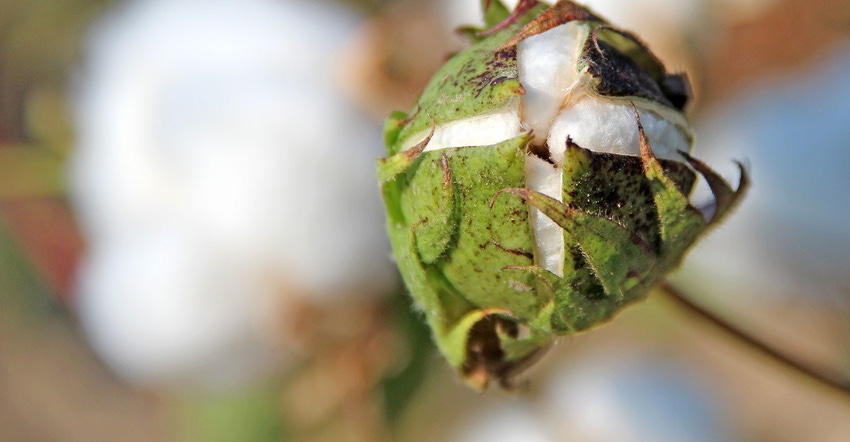
Harvest preparation will be a bit different for Arkansas cotton farmers this fall.
Rolling pickers into the field early will be an advantage to avoid late-season weather threats and to hold onto what looks to be a record yield, says University of Arkansas cotton specialist Bill Robertson.
“That first stretch at the start of the harvest season is important,” Robertson says. “We can take advantage of longer days in the field. Later in the season, as we cool off, we can’t start as early or stay as late.”
The 2020 crop also offers unique difficulties. Hurricane Laura, although not as damaging as expected, did create some unusual challenges.
“I was pleasantly surprised at how little impact we had from Laura,” Robertson says. “I had 4 inches of rain at my house. We have had close to another 3 inches from storms that came after Laura. My real concern for our cotton crop is boll rot.”
Tangled-up mess
He says the storm left cotton “leaning over but not laying down flat. Some cotton doesn’t look like anything happened to it; some fields are a tangled-up mess. It’s hard to walk through.”
Oddly, Robertson says, the cotton that’s still standing straight looks good but does not have the boll load of the tangled-up mess. “The tangled cotton should still pick well,” he says.
“For now, we are still set for a really good cotton yield. However, boll rot is becoming more prevalent in fields. We need a break from wet conditions.”
The National Agriculture Statistics Service (NASS) estimates a 1,195 pounds-per-acre yield. “We’re in perfect alignment with NASS,” Robertson says. “Our cotton looks good, really good boll retention all the way through the season. We have good plant height and a good uniform boll load.”
He says farmers are becoming more adjusted to applying heavier rates of Pix on aggressive varieties early.
Defoliation challenges
Defoliation will be interesting, he says. “We thought defoliation would be fairly easy before Laura hit; we had a big boll load, and the plant was getting tired. But Laura brought a lot of rain and wind. Now, regrowth potential is out the roof. Harvest aids are going to work differently.”
He says plant activity after the storm “jumped up.” Plant activity is hormone-driven, Robertson says. “It will take a bit more effort to get hormone balance where it needs to be to get leaves to fall off and bolls open. Harvest aids simply synchronize the natural process of defoliation and boll opening.”
He says farmers can’t afford to wait too long to begin the process. He also says relying on only percent open bolls to schedule harvest aid application might not be the best measure this year. “We need to get in the field and slice bolls,” he says.
“We may have fields mature enough to defoliate that are 40% open or less. Slice bolls to know where you are.”
He says cotton plants now “are so active that natural boll opening has slowed down. Bolls are still maturing; fiber development is driven by heat units, fibers continue to mature, but bolls are not opening as expected. The percent open boll guideline likely will be a terrible measure of maturity to schedule harvest aid timings this year.
Slice bolls
“Slicing bolls and monitoring heat units beyond cutout are likely our best measures to gauge maturity. I’m comfortable defoliating at 850 to 900 heat units after cutout.
“We are getting close,” he says, “especially in fields planted at the end of April that were flowering the first of July. It’s time to look at pulling the trigger.”
That first defoliation is really the only opportunity for a cotton farmer to set a schedule. “After that, we just stay ahead of the pickers,” he says.
Robertson expects some farmers to apply harvest aids by air, a practice that some hesitate to use but with wet soil conditions, tangled cotton, and the need to get started might be more appealing.
He says ground applications with 120-foot ground rigs will be common as the soil dries and the plants are not too tangled.
Time to start
“As soon as the weather allows, a lot of cotton farmers will begin to defoliate.
“Laura changed the complexion of this crop, Robertson says. “But we still have to get pickers in the field soon if we are going to finish by our goal of Nov. 1.”
Estimates indicate a near half-million-acre Arkansas cotton crop for harvest. “The Boll Weevil Eradication Program estimate is just shy of a half-million,” Robertson says. FSA estimates a half-million.”
The chore now, he says, is to take advantage of early fall weather and get the crop to the gin.
About the Author(s)
You May Also Like






